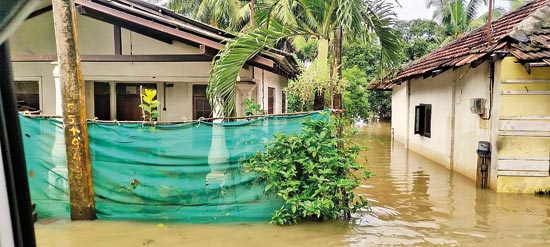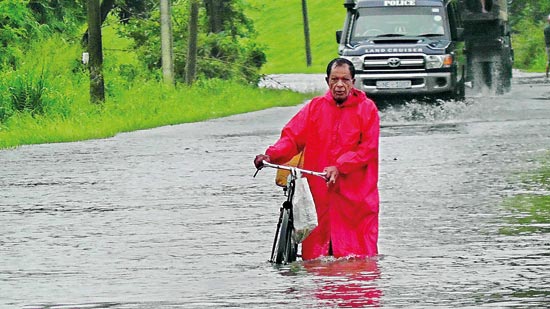News
Torrential rains disrupt lives of 200,000 people in several districts
Heavy rainfall across the country has caused significant disruption to lives and severe damage to property and crops in several districts.
According to officials, the number of affected people so far is 178,312. They are from the Badulla, Monaragala, Nuwara Eliya, Kandy, Ratnapura, Kegalle, Trincomalee, Batticaloa, Ampara, Mullaitivu, Hambantota, Kurunegala, and Puttalam districts.
The intense downpours have resulted in three deaths. At Medulla in Moneragala, a man drowned in the floods. The second death occurred after a tree fell on a man at Kotmale. Two people died in Batticaloa.
The Department of Meteorology said the rainfall in the North-Central, Uva, and Eastern provinces was likely to ease.

Batticaloa: The District Secretary says part of the reason for the severity of the floods was the lack of proper drainage
Due to heavy rains, all faculties of the Southeastern University except the applied sciences faculty were temporarily closed. The University Grants Commission said the university was at risk of being flooded.
As the railway track at Valachchenai was underwater, the Railways Department decided to cancel the ‘Meenagayaa’ intercity express train between Colombo Fort and Batticaloa. The service was resumed after the flood waters receded. The department also resumed the ‘Pulasthi’ express train, which was restricted to Polonnaruwa.
In the Ampara district, the area around the Deegawapiya stupa and the roads leading to the stupa were underwater. In Polonnaruwa, the Somawathiya Raja Maha Viharaya remains inundated, but some religious activities continue with devotees coming in catamarans and boats.
Earthslips in several areas in the Badulla district have disrupted transport. At the 7th mile post in Hali-Ela on the Badulla-Colombo main road, an earthslip cut off traffic, and it remained impassable as of Friday.
The Irrigation Department has said the water levels in most reservoirs have reached 96% of their full storage capacity.
The Department of Examinations has directed all GCE Advanced Level exam candidates to alternative schools due to earthslips disrupting traffic on the Badulla-Bandarawela route. Candidates have been arranged to sit for the exam at Badulla Central College and told to come 45 minutes early. Ampara District Secretary Chinthaaka Abeywickrama said students and teachers were being helped to sit for the G.C.E. A/L exam.
In Anuradhapura, floodwaters from the overflowing Thirappane Aru Wewa swamped roads in low-lying areas, halting traffic.
The overflowing of the Mahaweli River has inundated the Polonnaruwa-Batticaloa road. Only heavy vehicles are allowed. Residents are stranded in areas like Kinniya Mailapanchaveli, Lankapatuna, and Sungawila in the districts of Trincomalee and Polonnaruwa.
In Ampara, the Konduwatuwana reservoir has overflowed. In Nachchaduwa, six sluice gates were opened. In Kalawewa, two sluice gates were opened. The Yan Oya and Kanthale reservoirs have reached spill levels. Lunugamwehera had reached spill level, and many places in Tissamaharama were inundated.
In the Ratnapura district, the Galathura bridge has broken down.
According to Batticaloa District Secretary Justina Muraleetharan, part of the reason for the severity of the floods was the lack of proper drainage along newly built concrete roads. She said piled-up garbage was blocking the drains and preventing the flow of water.

Ampara. Pic by Wasantha Chandrapala
Irrigation Department Director General A. Gunasekara said the Senanayake Samudra had a low water level as recently as the beginning of January before spilling over for the first time in several years. He said he was hopeful that if the weather improved, as had been predicted, the spill should stop today. Although reservoirs were not damaged, canals and associated structures had been considerably affected, he said, adding that it would cost more than Rs. 2 billion to repair them. In Batticaloa, where nearly fifty percent of paddy land has been inundated by water, Arulanantharaja Ramesh, the Vice President of the Farmers’ Federation, blamed the authorities for the poor management of tanks for the disaster. Highlighting the Unnichchai tank, he charged that authorities failed to take the weather warnings into account when deciding the extent to which spill gates should be opened.
According to Mr. Ramesh, most of the paddy farmers sowed at the beginning of October, which would mean that paddy would have flowered, and the flood would have destroyed the crop.
Peradeniya University agriculture expert Prof. Buddhi Marambe said if indeed the 65,000 acres of paddy were destroyed as claimed, it would be a serious issue with more than 130,000 metric tonnes of paddy being lost.
For those affected by the flood, the reduced water levels do not signal an end to the suffering. Mr. Ramesh said that in the past, farmers had been compensated little, at most Rs. 23,000 per acre, despite the cost of production being Rs. 140,000 per acre. “Farmers are mentally disturbed,” he said, adding that it might push them to suicide.
So far, two deaths have been reported in Batticaloa, but Deputy Director of the District Disaster Management Centre in Ampara and Batticaloa, M.A.C.M. Riyas fears that the situation could worsen. “Children are playing in flood waters and some people are trying to travel on rafts. The public should be urged to avoid this as currents are strong and could lead to drowning. Furthermore, infectious diseases can easily spread.”
Mr. Riyas said some relief efforts were underway, “Cooked food and rations are being distributed; however, the economic crisis has made it difficult,” he said. “Even businesses and the community that would normally support don’t have the means to do so anymore.”
According to Prof. Marambe, the severe rains and flooding were caused by a combination of the El Nino effect, the Indian Ocean Dipole, and the North East monsoon. All factors are well-known and could have been anticipated, he said.
The best way to say that you found the home of your dreams is by finding it on Hitad.lk. We have listings for apartments for sale or rent in Sri Lanka, no matter what locale you're looking for! Whether you live in Colombo, Galle, Kandy, Matara, Jaffna and more - we've got them all!

